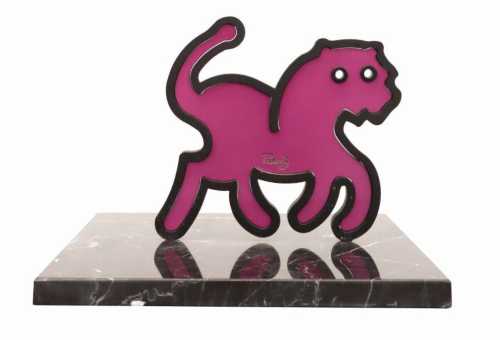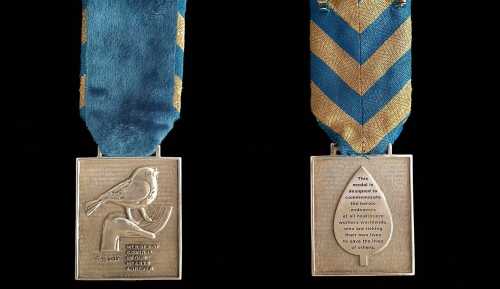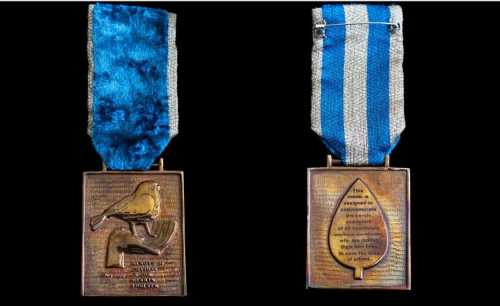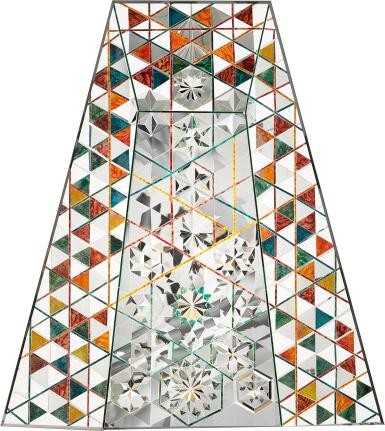- Untitled (Lovers) 1970 - 1979
- Bronze
- Sculpture
- 63 * 8 * 146 cm
23 March 2022
Estimation
£60,000
79,103 USD
-
£80,000
105,471 USD
Realized Price
£138,600
182,729 USD
98%
Artwork Description
“Iranian themes had possessed the very fibre of my being and haunted my thoughts.”
- TANAVOLI, AS QUOTED BY SHIVA BALAGHI, MONOGRAPH, P.29.
This carved relief of two totemic figures standing on short legs, with long vertical bodies covered in Arabic letters including heeches and with zoomorphic heads turned inwards, represents lovers reaching to each other. This painting is rich in references to the cultural universe of Tanavoli. The head of the individual on the right is reminiscent of the cockerel pattern, particularly popular in Kashan ceramics from Medieval Iran (see Sotheby’s 2018, lot 128). Similarly, these standing profiles on a carved relief are reminiscent of the murals that ornamented Ancient Persia’s greatest monuments. Just like the bas-reliefs of ancient Persepolis, this sculpture symbolizes the greatness of Iran, by referring to a rich range of local cultural facts and practices. The artist himself describes being awestruck during his first visit to the city, upon realizing he descended from the figures on these walls. These became a central part of his visual language, just as his famous Heech series came to be the emblem of his philosophical engagement. Tanavoli’s “Heeches”, literally ‘Nothings’ do not infer a negation, but rather the selflessness that expresses itself within hope and friendship. Adapted as calligraphy, they become both an object and a language, applicable to a variety of poses and feelings.
Still deeply active in the Iranian and international art market after six decades of activity, Parviz Tanavoli endeavours to build an enduring legacy for his homeland. Considered one of the most important artists from Iran, a pioneer and co-founder of the Saqqa-khane school, and a mentor for many young artists, Tanavoli derives his pictorial style from Persian culture and mythology. Most of his sculptures offer new narratives for the tales of his forefathers, which he treasures and strives to pass down for perenniality.

Throughout his career, Tanavoli built a whole landscape of three-dimensional art, connecting Iranian features with new styles inspired by Pop art, often characterized by a minimalistic, almost naive outlook. Tanavoli was first animated by the desire to challenge “pretty art”, as promoted by the school of Kamal-ol Mulk that prevailed in Iran at the time. In doing so, Tanavoli forged his very own conception of being an artist, displaying his talent in every possible way. But despite his remarkable rugs, paintings or jewellery creations, Tanavoli essentially always remained a sculptor, a role he believes to be indissociable from that of poet (Tanavoli 2020).
His Lovers series is an ode to the famous Persian love story of Shirin and Farhad. Tanavoli looks upon the character of Farhad both as a muse and a role model. In folk stories, he was a stonecutter who fell in love with the Armenian princess Shirin. His rival, Sassanian king Khosrow Parviz, promised him to let him marry the Princess if he manages to carve a set of stairs in the Behistun Mountain, an impossible task. But as he sees Farhad succeeding in his mission, Khosrow tricks him into believing that Shirin is dead, whereupon the sculptor kills himself. This timeless tale of love and fate played a crucial role in Tanavoli’s artistic output. As he took the responsibility to revive the art of sculpture in Iran, turning himself into Farhad’s disciple, he created various works showing the carver and himself in tender embraces, in a common Sufis depiction of devotion. With time, other figures replaced him in these works, giving birth to the Lovers series.
“A creative blend of classical poetry, Shiite rituals, tribal crafts and ancient Persian monuments, Tanavoli’s art is, in a sense, an amalgamated record of Iranian cultural history.”
“A creative blend of classical poetry, Shiite rituals, tribal crafts and ancient Persian monuments, Tanavoli’s art is, in a sense, an amalgamated record of Iranian cultural history.”
- SHIVA BALAGHI IN MONOGRAPH, P.39.
More lots by Parviz Tanavoli

Untitled
Estimation
1,500,000,000﷼
2,481 USD
-
2,000,000,000﷼
3,309 USD
Realized Price
1,400,000,000﷼
2,316 USD
20%
Sell at
Sale Date
Smart Auction
-
2 August 2024
Realized Price
128,001 USD
Min Estimate
68,579 USD
Max Estimate
96,026 USD
Average Artwork Worth
+74.318%
Average Growth of Artwork Worth
Sales Performance Against Estimates
Average & Median Sold Lot Value
2021 - 2025
Performance vs. Estimate
2021 - 2025
Sell-through Rate
2021 - 2025



